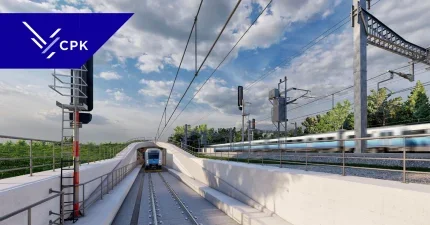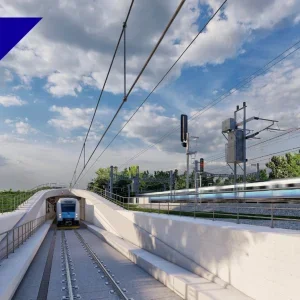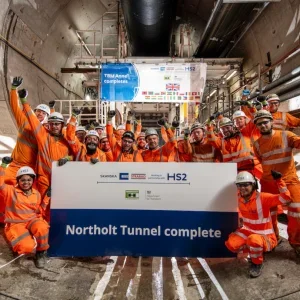
Poland’s Centralny Port Komunikacyjny (CPK) has awarded Porr the contract for the construction of a 4.6km, 14m-diameter high-speed rail tunnel.
The PLN 2.2bn (€400m) contract covers a key section of railway line no. 85 – the so-called ‘Y’ line – which by 2032 will connect Warsaw and the CPK Airport with Łódź, and by 2035 will enable the launch of the fastest high-speed rail services to Wrocław and Poznań.
It will be the longest and widest rail tunnel in Poland to be constructed in a single section using a TBM. Trains will pass beneath the city centre at depths of 25-35m.
The ‘Y’ line will also be part of the trans-European North Sea–Baltic Sea corridor, designated by the European Union as part of the TEN-T transport network.
Porr will have four years from the date of contract signing to complete the works and construction is expected to start later this year. Budimex is currently constructing the Rekinia TBM launch shaft and the Fabryczna reception shaft. Tunnelling is expected to start in Q4 next year.
Porr SA CEO Piotr Kledzik welcomed the contract award.
“We’re honoured to lead the CPK tunnel project, one of unprecedented scale and complexity in Poland. Our experienced team is well-versed in advanced technologies and in delivering projects in dense, geologically challenging urban areas. I’m confident our expertise and commitment will ensure safe, efficient, and timely completion,” he said.
Porr CEO Karl-Heinz Strauss said the project’s size and complexity was unprecedented in Poland. “That’s why we’re especially pleased about the trust that CPK has placed in us by awarding us the contract for the tunnel. We’re aware of what a responsibility this is,” he said
The CPK tunnel in Łódź is the second tunnel project in the city and it will mainly serve long-distance trains.
It will accommodate trains travelling at speeds of up to 160km/h thanks not only to the structure itself but also Porr’s Slab Track Austria technology In contrast to conventional superstructures, in which the rails are attached to sleepers lying on a layer of ballast, Slab Track Austria technology uses a prefabricated concrete slab as a base. Its long service life, stability and track accuracy, as well as the comparatively low noise and vibrations caused by passing trains, allows it to be used on high-speed lines with speeds up to 400km/h. It is the first time the technology has been used in Poland.
Piotr Malepszak, undersecretary of state at the Ministry of Infrastructure, said the project was backed by solid economic and operational data and was closely co-ordinated with PKP PLK’s metropolitan tunnel, which would improve travel within the city.
CPK CEO Dr Filip Czernicki said the new railway line, like the entire CPK infrastructure, was built to dual-use standards – for both civilian and military purposes.
“The HSR lines, the CPK Airport, and the surrounding road network are all being constructed to safety standards set by the Polish government and the European Union. The CPK project will be a vital component of Poland’s resilience system in times of crisis,” he said.
CPK’s investment in an integrated transport system, including the new airport, high-speed rail, and road networks, all being developed simultaneously, is set to transform Poland’s connectivity, drive economic growth, and position the country as a major European transport hub. Scheduled to open in 2032, CPK will serve as Poland’s new central airport.
To date, Porr has completed several major tunnel projects in Poland. These include the S3 Bolków-Kamienna Góra tunnels, which opened to traffic in July last year, and the TS-26, which at around 2,300m is the longest non-urban tunnel with hard rock tunnelling and was built using the New Austrian Tunnelling Method.
Porr also built a tunnel under the Świna Strait, which connects the islands of Usedom and Wolin in Świnoujście. In addition, it widened a historic railway tunnel in the Lower Silesian Voivodeship, where the tunnel-in-tunnel method was used for the first time in Poland.







